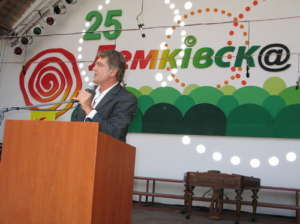Today

on “Lemkivska Vatra” festival in Zhdynia, Poland
July 20- 22, 2007
Until 1956, the Lemkos as well as all the other Ukrainians in Poland had no national rights. Ukrainian cultural and educational activity centered around the Ukrainian Social and Cultural Society. In 1957, the supplement Lemkivs’ke slovo was added to the society’s weekly Nashe slovo , and in 1959 a separate section for the development of Lemko culture was established within the society. Only a few Lemkos have been allowed to return to their homeland—by 1957–8 only some 4,000 of the 30,000 to 40,000 Lemkos in Poland . They are dispersed in the Gorlice and Sanok regions and form a majority in only a few villages. The return movement has been halted, although large areas of the Lemko region are uninhabited; in Lisko county, for example, the population density is 25 per sq km, whereas in 1939 it was 70 per sq km. Schools in which Ukrainian is taught are the exception in the Lemko region. Until recently, Lemkos did not have their own priests; they often were, and still are, subject to greater discrimination than before the Second World War.
The Lemkos who moved to Ukraine were settled mainly in former Polish villages in the Ternopil, Sambir, and Lviv regions. Some live in the Donbas . In Ukraine , as in Poland , they try to preserve their own folklore, especially their folk songs and dances. But the younger generation is losing its distinctive traits. Some Ukrainian monuments have been preserved in the Polish museums in Sanok, Nowy Sacz, Rzeszów, and Peremyshl as well as in Lviv. Most of them, however, have been destroyed, or, lacking government protection, continue to deteriorate. Representatives of Solidarnosc criticized the Polish authorities for resettling the Lemkos, but most Poles consider the Lemkos to be part of the Polish, not the Ukrainian, nation.
The Lemkos are a distinct ethnic group within the Ukrainian nation. Their dialects and spiritual and material culture preserved some unique archaic elements that have been lost by other Ukrainian ethnic groups. They also absorbed some Slovak and Polish influences, especially linguistic ones. More than any other Ukrainian ethnic group, the Lemkos are attached to their homeland, traditions, and church and are impervious to external influence. They are more united than other groups, even when they are outside their native land.
Visit SFULO website: www.sfulo.com
Source: Encyclopedia of Ukraine, Shevchenko Scientific Society


